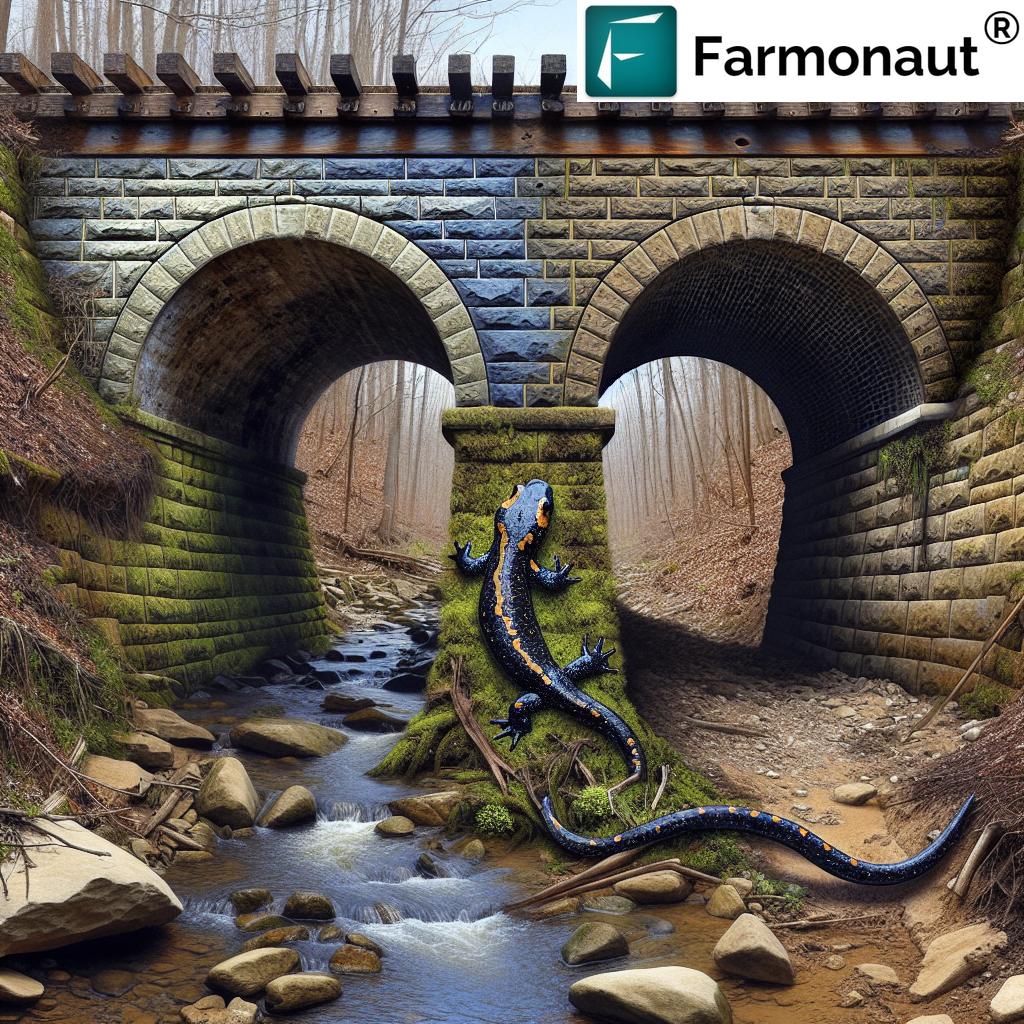Historic Ohio Railroad Bridge Restoration: Preserving Nature and History in Jefferson County
“The Hellbender Preserve restoration project in Ohio repurposes stones from a nearby road to restore a 19th-century bridge.”
In the heart of Jefferson County, Ohio, a remarkable project is underway that seamlessly blends the preservation of our nation’s rich railroad heritage with cutting-edge nature conservation efforts. We’re excited to share the fascinating story of the historic bridge restoration that’s transforming an old railroad trestle into the Hellbender Preserve, a vital component of the ambitious Great American Rail-Trail initiative.
This innovative project not only breathes new life into a 19th-century stone bridge with a presidential connection but also showcases the power of creative problem-solving in historic preservation. By repurposing stones from a nearby road project, the restoration team is writing a new chapter in the bridge’s storied history while simultaneously protecting crucial habitat for Ohio’s largest population of hellbender salamanders.

As we delve into this inspiring tale of local collaboration, we’ll explore how the project brings together community improvement, soil and water conservation, and exciting public recreation opportunities. We’ll uncover the challenges faced in sourcing authentic materials for such restorations and the creative solutions found along the way. This project promises not only to safeguard our natural and cultural heritage but also to become a significant regional tourism draw.
The Birth of a Preservation Dream
Our journey begins in East Liverpool, Ohio, where a seemingly routine road project along state Route 39 in the East End area set the stage for an extraordinary conservation effort. Large stones removed during this Ohio Department of Transportation (ODOT) culvert project more than a year ago found a temporary home at the former Riverview Florist property on Parkway. Little did anyone know at the time that these stones would soon play a crucial role in preserving a piece of American history.
Enter Aaron R. Dodds, the visionary projects manager for Jefferson Soil and Water Conservation District. Dodds recognized the potential of these discarded stones and saw an opportunity to breathe new life into a historic bridge in Jefferson County. This bridge, as we’ll soon discover, holds a special place in the annals of American history.
A Bridge with Presidential Connections
The stone bridge at the center of this restoration project began its life as a wooden trestle bridge, bearing witness to some of the most significant moments in American history. In 1771, it had the honor of being visited by none other than President George Washington himself. Nearly a century later, it would play host to another presidential figure, this time with a dash of drama added to the mix.
On February 14, 1861, President-elect Abraham Lincoln was making his way to his inauguration in Washington, D.C. His journey took him along the Steubenville and Indiana Railroad, bringing him to Cadiz Junction. It was here that fate intervened, adding a touch of peril to the future president’s trip.
As Lincoln’s train approached the wooden trestle, news arrived that a large tree had broken loose and crashed into the structure. The impact had compromised the trestle, causing it to sway, crack, and creak ominously. The train and its precious cargo of the president-elect came perilously close to plunging into the creek below.
Quick thinking prevailed, and it was decided that the passengers, including Lincoln, would disembark and walk across the trestle. The train would follow with only the crew aboard, minimizing the risk. As Lincoln made his way across, accounts vary as to whether he slipped and fell prone onto the tracks or merely to his knee. What’s certain is that the future president came dangerously close to falling 37 feet into the ice-filled stream below.
This near-miss left a lasting impression on Lincoln. On June 12, 1861, now firmly established as President, he signed an executive order funding the construction of a stone bridge to span Cross Creek, replacing the wooden trestle where he had his close call. This decision would prove to be a crucial moment in the bridge’s history, setting the stage for the preservation efforts we see today.
The Challenges of Historic Preservation
Fast forward to the present day, and we find this historic bridge in need of significant restoration. Since the railroad abandoned this section of track in the 1950s, bypassing the tunnels, the bridge has suffered from a lack of maintenance. The ravages of time, coupled with damage from ice and stream debris, have taken their toll on this once-mighty structure.
One of the most significant challenges in restoring historic structures like this bridge is sourcing authentic materials. Dodds and his team have spent five years searching for stones of the right size and quality to match the original construction. As Dodds explained, “To get ones this size is almost impossible. When departments of transportation get them, they hoard them because they can’t find them.”
This scarcity of suitable materials highlights the importance of the stones recovered from the East Liverpool road project. These 3-foot-long by 20-inch-tall stones are, in Dodds’ words, “priceless” for the restoration effort. The project will require about 18 of these stones to complete the work on the “huge bridge.”
The Hellbender Preserve: Where History Meets Conservation
“Jefferson County’s historic bridge restoration protects habitat for Ohio’s largest population of hellbender salamanders, North America’s largest amphibian.”
The bridge restoration is just one part of a larger conservation initiative known as the Hellbender Preserve. This project, spearheaded by the Jefferson Soil and Water Conservation District, aims to transform an old railroad corridor into a nature preserve that will serve multiple purposes.
At the heart of this preserve is the protection of Ohio’s largest population of hellbender salamanders. These fascinating creatures, the largest amphibians in North America, have found a home in the streams and waterways around the historic bridge. By restoring the bridge and preserving the surrounding area, the project ensures that these unique salamanders will continue to thrive in their natural habitat.

The Hellbender Preserve is also set to become a key section of the Rails-to-Trails Conservancy’s Great American Rail-Trail. This ambitious project aims to create a continuous trail spanning from Washington, D.C. to Washington State, utilizing former railroad corridors. The inclusion of the Hellbender Preserve in this network ensures that it will become part of a larger, nationwide initiative promoting outdoor recreation and non-motorized transportation.
Community Collaboration and Funding
The success of this project hinges on the collaborative efforts of various community stakeholders. The East Liverpool City Community Improvement Corporation (CIC) played a crucial role by approving the donation of the stones from the Riverview property for use in the bridge restoration.
Funding for the project comes from the Jefferson County Commissioners, who have allocated American Rescue Plan money to support this important initiative. This use of federal funds demonstrates the project’s significance not just for local heritage preservation but also as part of broader economic recovery efforts.
The restoration work itself is being carried out by a team of contractors, including specialists in this type of historical restoration. These experts bring the necessary skills and experience to ensure that the bridge is restored to its former glory while maintaining its historical integrity.
The Future of the Hellbender Preserve
Looking ahead, the Hellbender Preserve promises to be much more than just a restored bridge. As Dodds outlined in his letter to the CIC, “Our hope is that the Hellbender Preserve property and the bicycle trail that will also serve on the Industrial Heartland Trail Network, which East Liverpool also sits upon, will be a regional draw for tourism.”
The preserve is set to be unveiled on Celebrate Trails Day, April 26, with a grand opening scheduled from 10 a.m. to 4 p.m. at the Hellbender Preserve, located at 800 County Road 36, Bloomingdale. This event will mark the culmination of years of planning, fundraising, and hard work, offering the public their first glimpse of this remarkable achievement in historic preservation and environmental conservation.
Innovative Approaches to Conservation and Restoration
The Hellbender Preserve project showcases several innovative approaches to conservation and restoration that set it apart from traditional efforts. Let’s explore some of these unique aspects:
- Material Repurposing: By utilizing stones from a nearby road project, the restoration team demonstrates a commitment to sustainability and resourcefulness. This approach not only solves the challenge of sourcing authentic materials but also reduces waste and the environmental impact of the project.
- Dual-Purpose Conservation: The project simultaneously addresses historical preservation and wildlife conservation. By restoring the bridge, it safeguards an important piece of railroad history while also protecting critical habitat for the hellbender salamanders.
- Integration with National Initiatives: By incorporating the preserve into the Great American Rail-Trail, the project ensures long-term relevance and connectivity to a broader network of trails and conservation areas.
- Community Engagement: The collaboration between various local entities, from the city improvement corporation to county commissioners, showcases the power of community-driven conservation efforts.
To better illustrate how the Hellbender Preserve project compares to traditional conservation efforts, let’s take a look at this comparison table:
| Project Aspect | Hellbender Preserve Approach | Traditional Conservation Method |
|---|---|---|
| Material Sourcing | Repurposed stones from nearby road project | New materials or commercially sourced historical replicas |
| Habitat Protection | Focused on hellbender salamanders and stream ecology | General wildlife protection measures |
| Historical Preservation | Restoration of 19th-century bridge with presidential connection | Typically focuses on preserving or recreating historical structures |
| Community Impact | Regional tourism draw and part of national trail network | Local park or nature reserve creation |
| Estimated Project Cost | $2-3 million (including bridge restoration and trail development) | $500,000 – $1 million for similar-sized conservation area |
| Projected Annual Visitors | 50,000 – 100,000 (part of national trail network) | 10,000 – 25,000 for a local nature preserve |
| Protected Habitat Area | Approximately 200 acres (including stream and surrounding land) | 50-100 acres for a typical local nature preserve |
The Role of Technology in Modern Conservation
While the Hellbender Preserve project focuses on historical preservation and traditional conservation methods, it’s worth noting how modern technology is revolutionizing other aspects of environmental management and sustainable agriculture. For instance, companies like Farmonaut are leveraging satellite technology and artificial intelligence to assist farmers in optimizing their crop yields while minimizing environmental impact.
Farmonaut’s platform provides valuable services such as real-time crop health monitoring, AI-based advisory systems, and resource management tools. These technologies can be particularly useful in areas surrounding conservation projects like the Hellbender Preserve, helping to ensure that agricultural practices in the region are compatible with environmental preservation efforts.
For example, Farmonaut’s carbon footprinting feature could be valuable for farmers and businesses in Jefferson County looking to reduce their environmental impact and support the overall conservation goals of the region. Similarly, the traceability solutions offered by Farmonaut could help local agricultural producers showcase the sustainability of their practices, potentially creating new eco-tourism opportunities that complement the Hellbender Preserve.
The Impact on Local Agriculture and Economy
The restoration of the historic bridge and the creation of the Hellbender Preserve are set to have a significant impact on the local economy, particularly in the agricultural sector. As the preserve attracts more visitors, there’s potential for growth in agritourism and related industries.
Local farmers could benefit from this increased visibility by adopting sustainable farming practices and leveraging technology to showcase their commitment to environmental stewardship. For instance, crop loan and insurance services that utilize satellite-based verification could help farmers in the region access better financial products, supporting the growth of sustainable agriculture in the area.
Moreover, the increased focus on conservation and sustainable practices could open up new markets for local farmers. Visitors to the Hellbender Preserve might be more inclined to purchase locally-grown, environmentally-friendly produce, creating a virtuous cycle of conservation and economic development.
Educational Opportunities and Public Engagement
The Hellbender Preserve project offers numerous educational opportunities for the local community and visitors alike. From learning about the history of the railroad and President Lincoln’s connection to the bridge to understanding the ecological importance of hellbender salamanders, the preserve can serve as an outdoor classroom for people of all ages.
Public engagement will be crucial to the long-term success of the preserve. Initiatives such as guided tours, citizen science projects to monitor salamander populations, and workshops on sustainable land management could help foster a sense of community ownership and stewardship of the preserve.
Technology could play a role here as well. For instance, fleet management solutions could be utilized to organize and optimize educational field trips to the preserve, ensuring efficient and sustainable transportation for school groups and other visitors.
Looking to the Future: Sustainability and Growth
As we look to the future, the Hellbender Preserve project serves as a model for how communities can preserve their historical heritage while also protecting vital ecosystems. The success of this project could inspire similar initiatives across Ohio and beyond, creating a network of preserved spaces that honor our past while safeguarding our environmental future.
The integration of modern agricultural technologies, like those offered by Farmonaut, with traditional conservation efforts could pave the way for a new era of sustainable land management. By combining historical preservation, ecological conservation, and cutting-edge farming practices, regions like Jefferson County can create resilient, sustainable communities that thrive economically while protecting their natural and cultural resources.
Frequently Asked Questions
- What is the Hellbender Preserve?
The Hellbender Preserve is a conservation project in Jefferson County, Ohio, that combines the restoration of a historic 19th-century railroad bridge with efforts to protect the habitat of hellbender salamanders. - Why is the bridge historically significant?
The bridge has connections to two U.S. presidents: George Washington visited it in 1771, and Abraham Lincoln had a near-accident on it in 1861, which led to its reconstruction as a stone bridge. - How are the stones for the restoration being sourced?
The project is repurposing large stones removed during a road project along state Route 39 in East Liverpool, Ohio. - What is the Great American Rail-Trail?
It’s an initiative to create a continuous trail from Washington, D.C. to Washington State using former railroad corridors. The Hellbender Preserve will be part of this trail. - How is the project being funded?
The restoration is being funded by Jefferson County Commissioners using American Rescue Plan money.
Conclusion: A Bridge to the Future
The Historic Ohio Railroad Bridge Restoration project in Jefferson County stands as a testament to the power of community collaboration, innovative problem-solving, and a deep respect for both natural and cultural heritage. By breathing new life into this 19th-century stone bridge, the project not only preserves a tangible link to our past but also creates a sustainable future for the region’s unique wildlife and ecosystems.
As we look forward to the grand opening of the Hellbender Preserve, we’re reminded of the importance of such initiatives in connecting us to our history, our environment, and each other. This project serves as an inspiring model for how communities across the nation can approach conservation and restoration efforts, blending respect for the past with a vision for a sustainable future.
Whether you’re a history enthusiast, a nature lover, or simply someone who appreciates the power of community-driven initiatives, the Hellbender Preserve promises to be a destination worth visiting. As it takes its place as part of the Great American Rail-Trail, this restored bridge will continue to serve as a crossing point – not just over Cross Creek, but between our past and our future, between human history and natural conservation.
We invite you to visit the Hellbender Preserve when it opens, to walk in the footsteps of presidents, to marvel at the engineering of a bygone era, and to witness firsthand the delicate balance between preservation and progress. In doing so, you’ll be part of the next chapter in this bridge’s long and storied history – a chapter that promises to be as rich and inspiring as those that came before.
Earn With Farmonaut: Affiliate Program
Earn 20% recurring commission with Farmonaut’s affiliate program by sharing your promo code and helping farmers save 10%. Onboard 10 Elite farmers monthly to earn a minimum of $148,000 annually—start now and grow your income!
















